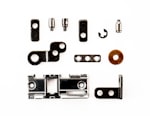Canada joined the USA, Sweden and Finland for three games of junior player evaluation action in Michigan last week, and they lost them all. They got one loser point in the standings table for an overtime loss.
Sweden led the way with eight points in five games, and Team USA and Finland were second with six points.
Canada couldn't even outdo the two USA split squads that started the tournament. Canada was bad. Obviously.
The Toronto Sun's Bob Duff thinks it's the coach's fault:
A Hockey Canada veteran, a former Olympian who was among the scores of NHL people here to scout the event, suggested that the Canadians were the victims of over-coaching, that their natural talents were being squeezed out of their game by the obsessive need to play within the system.
An NHL GM went as far as to suggest that the European teams are better coached in the ways of the game than Canada, and certainly the Swedes and Finns played with much more flow and skill than was exhibited by Canada.
The Canadians looked rigid, like they were thinking too much instead of reacting to situations. They always appeared to be a step slower than their opponents.In the final game that Canada lost, they were playing Team USA on Saturday evening.
After one, USA leads Canada 2-0. Canada trying to make the pretty passes. Need to settle down in second.
— Kristen Shilton (@kristen_shilton) 6 August 2016
Canada outshot the USA 22-10 in that period of hockey. If they were pausing to make pretty passes first, they were doing it at breakneck speed.
USA Hockey posted some numbers for these games, and I calculated the shots on goal per game played from them:
| Team | GP | G | A | PTS | SOG | SOG % | SOG/GP | PEN | PIM |
|---|---|---|---|---|---|---|---|---|---|
| Sweden | 5 | 20 | 23 | 43 | 157 | 12.7 | 31 | 24 | 56 |
| USA White | 2 | 11 | 17 | 28 | 93 | 11.8 | 47 | 8 | 18 |
| USA Blue | 2 | 14 | 14 | 28 | 82 | 17.1 | 41 | 12 | 24 |
| Team USA | 3 | 10 | 14 | 24 | 119 | 8.4 | 40 | 15 | 38 |
| Finland | 5 | 9 | 13 | 22 | 111 | 8.1 | 22 | 21 | 54 |
| Canada | 3 | 3 | 3 | 6 | 109 | 2.8 | 36 | 14 | 28 |
Team Canada seemed to find a lot of time to shoot while they were being wooden and uncreative and obviously bad. They did not shoot as much as their North American neighbours, but they outdid the Swedes and the very offensively anaemic Finns.
There's nothing like a shooting percentage of 2.8% to have everyone scrambling to find a narrative to explain it. I was focusing on the goaltending as the games went on.
| # | Name | Team | GP | MIN | SOG | SV | GA | GAA | SV % |
|---|---|---|---|---|---|---|---|---|---|
| 1 | Tyler Parsons | USA | 2 | 60:00:00 | 36 | 35 | 1 | 1 | 0.972 |
| 1 | Felix Sandstrom | SWE | 3 | 120:00:00 | 85 | 81 | 4 | 2 | 0.953 |
| 35 | Jake Oettinger | Blue | 2 | 64:02:00 | 34 | 32 | 2 | 1.87 | 0.941 |
| 35 | Jake Oettinger | USA | 1 | 58:31:00 | 27 | 25 | 2 | 2.05 | 0.926 |
| 31 | Veini Vehviläinen | FIN | 5 | 246:22:00 | 145 | 133 | 12 | 2.92 | 0.917 |
| 3 | Connor Ingram | CAN | 2 | 69:53:00 | 36 | 33 | 3 | 2.58 | 0.917 |
| 35 | Filip Gustavsson | SWE | 3 | 124:00:00 | 71 | 65 | 6 | 2.9 | 0.915 |
| 30 | Adam Werner | SWE | 4 | 58:40:00 | 51 | 46 | 5 | 5.11 | 0.902 |
| 30 | Joseph Woll | USA | 2 | 60:00:00 | 29 | 26 | 3 | 3 | 0.897 |
| 31 | Evan Sarthou | Blue | 2 | 55:58:00 | 23 | 20 | 3 | 3.22 | 0.870 |
| 30 | Joseph Woll | White | 2 | 61:30:00 | 37 | 32 | 5 | 4.88 | 0.865 |
| 1 | Tyler Parsons | White | 2 | 56:45:00 | 22 | 19 | 3 | 3.17 | 0.864 |
| 1 | Evan Cormier | CAN | 2 | 51:29:00 | 20 | 16 | 4 | 4.66 | 0.800 |
| 2 | Carter Hart | CAN | 1 | 53:10:00 | 20 | 16 | 4 | 4.51 | 0.800 |
| 1 | Markus Ruusu | FIN | 5 | 60:00:00 | 32 | 24 | 8 | 8 | 0.750 |
Tyler Parsons of the USA, who played two half games, had a .972 save percentage. Professional Swedish goalie, Felix Sandstrom, who played even more minutes, had a .953.
Canada's best goalie turned in a fairly respectable .917, tied with Veini Vehviläinen, the professional Finnish goalie who played most of their games including their 2-1 win over the Americans. But the other two Canadian goalies each batted .800. That is, obviously, pretty bad.
I don't want to discount everything that people watching these games say they saw. Perhaps the Canadian team was a little moribund and by the numbers playing in August.
But what the numbers actually show is that Canada shot the puck at a high rate, had some very, very bad puck luck, and combined that with nearly two full games worth of terrible goaltending results.
Some of the causes might be poor offensive choices or poor defensive play. There might be some room for better coaching and systems. Or maybe three games in August is, obviously, not enough to judge from.
Another view:
#WJEC: The SWE-FIN game was structured, crisp and beyond boring. This USA-CAN game is a shit show for every player except G Tyler Parsons.
— Steve Kournianos (@TheDraftAnalyst) 7 August 2016
Duff seeks to tie the issue into the Subban trade and the culture of boring hockey in the NHL that punishes high-risk play. I'm always ready to see the professional experience of players from the Swedish and Finnish teams as leading to tighter systems and more mature play. Maybe we're both wrong, and it was just the random swings of luck--good and bad--that don't really mean anything at all.



